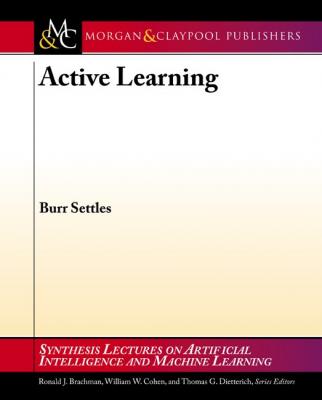Active Learning. Burr Settles
Читать онлайн.| Название | Active Learning |
|---|---|
| Автор произведения | Burr Settles |
| Жанр | Компьютерное Железо |
| Серия | Synthesis Lectures on Artificial Intelligence and Machine Learning |
| Издательство | Компьютерное Железо |
| Год выпуска | 0 |
| isbn | 9781681731766 |
3 Searching Through the Hypothesis Space
3.1 The Version Space
3.2 Uncertainty Sampling as Version Space Search
3.3 Query by Disagreement
3.4 Query by Committee
3.5 Discussion
4 Minimizing Expected Error and Variance
4.1 Expected Error Reduction
4.2 Variance Reduction
4.3 Batch Queries and Submodularity
4.4 Discussion
5 Exploiting Structure in Data
5.1 Density-Weighted Methods
5.2 Cluster-Based Active Learning
5.3 Active + Semi-Supervised Learning
5.4 Discussion
6.1 A Unified View
6.2 A PAC Bound for Active Learning
6.3 Discussion
7.1 Which Algorithm is Best?
7.2 Real Labeling Costs
7.3 Alternative Query Types
7.4 Skewed Label Distributions
7.5 Unreliable Oracles
7.6 Multi-Task Active Learning
7.7 Data Reuse and the Unknown Model Class
7.8 Stopping Criteria
Preface
Machine learning is the study of computer systems that improve through experience. Active learning is the study of machine learning systems that improve by asking questions. So why ask questions? (Good question.) The key hypothesis is that if the learner is allowed to choose the data from which it learns—to be active, curious, or exploratory, if you will—it can perform better with less training. Consider that in order for most supervised machine learning systems to perform well they must often be trained on many hundreds or thousands of labeled data instances. Sometimes these labels come at little or no cost, but for many real-world applications, labeling is a difficult, time-consuming, or expensive process. Fortunately in today’s data-drenched society, unlabeled data are often abundant (or at least easier to acquire). This suggests that much can be gained by using active learning systems to ask effective questions, exploring the most informative nooks and crannies of a vast data landscape (rather than randomly and expensively sampling data from the domain).
This book was written with students, researchers, and other practitioners of machine learning in mind. It will be most useful to those who are already familiar with the basics of machine learning and are looking for a thorough but gentle introduction to active learning techniques. We will assume a basic familiarity with probability and statistics, some linear algebra, and common supervised learning algorithms. An introductory text in artificial intelligence (Russell and Norvig, 2003) or machine learning (Bishop, 2006; Duda et al., 2001; Mitchell, 1997) is probably sufficient background. Ardent students of computational learning theory might find themselves annoyed at the lack of rigorous mathematical analysis in this book. This is partially because, until very recently, there has been little interaction between the sub-communities of theory and practice within active learning. While some discussion of underlying theory can be found in Chapter 6, most of this volume is focused on algorithms at a qualitative level, motivated by issues of practice.
The presentation includes a mix of contrived, illustrative examples as well as benchmark-style evaluations that compare and contrast various algorithms on real data sets. However, I caution the reader not to take any of these results at face value, as there are many factors at play when choosing an active learning approach. It is my hope that this book does a good job of pointing out all the subtleties at play, and helps the reader gain some intuition about which approaches are most appropriate for the task at hand.
This active learning book is the synthesis of a previous literature survey (Settles, 2009) with material from other lectures and talks I have given on the subject. It is meant to be used as an introduction and reference for researchers, or as a supplementary text for courses in machine learning—supporting a week or two of lectures—rather than as a textbook for a complete full-term course on active learning. (Despite two decades of research, I am not sure that there is enough breadth or depth of understanding to warrant a full-semester course dedicated to active learning. At least not yet!) Here is a road map:
• Chapter 1 introduces the basic idea of, and motivations for, active learning.
• Chapters 2–5 focus on different “query frameworks,” or families of active learning heuristics. These include several algorithms each.
• Chapter 6 covers some of the theoretical foundations of active learning.
• Chapter 7 summarizes the various pros and cons of algorithms covered in this book. It outlines several important considerations for active learning in practice, and discusses recent work aimed at addressing these practical issues.
I have attempted to wade through the thicket of papers and distill active learning approaches into core conceptual categories, characterizing their strengths and weaknesses in both theory and practice. I hope you enjoy it and find it useful in your work.
Supplementary
